Introduction
The 10th generation Core series finally features hyper-threading technology across the board, while the high-end i9 series has been upgraded to more 10-core processors. For a long time, Intel’s consumer-grade processors have been marketed with the slogan “born for gaming.” Today, we will conduct a detailed comparison of gaming frame rates between the 9th generation i9-9900K and the 10th generation i9-10900K. We also aim to resolve a question that has circulated online: does hyper-threading affect gaming frame rates? Let’s see how much performance improvement we can get when hyper-threading is turned off for each CPU.
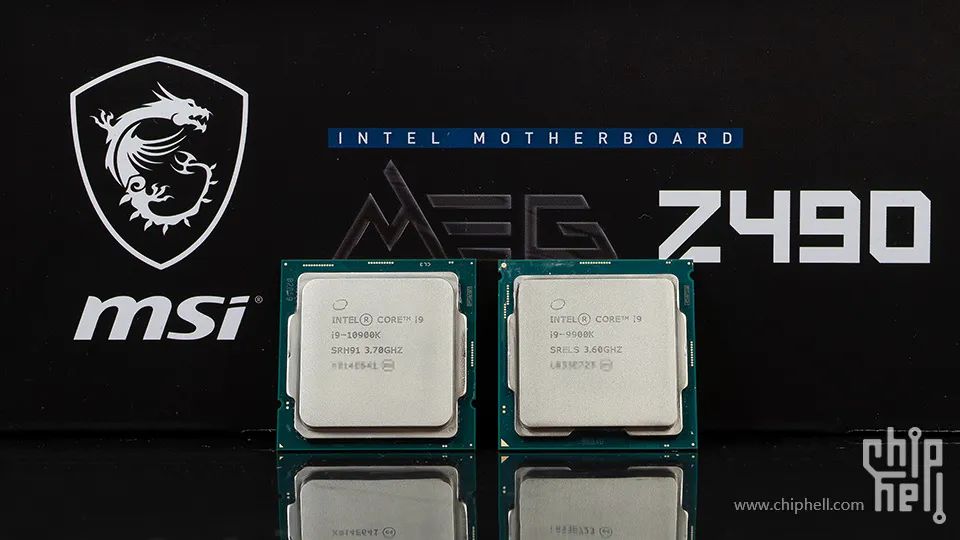 Of course, many players are already familiar with the performance of default and overclocked settings. Therefore, comparing performance at the same frequency is likely what players care about most, as most buyers of K-series processors are looking for overclocking capabilities. Additionally, we will explore the differences in voltage, temperature, and power consumption when overclocking the 9th and 10th generation Core i9 processors in this article.
Of course, many players are already familiar with the performance of default and overclocked settings. Therefore, comparing performance at the same frequency is likely what players care about most, as most buyers of K-series processors are looking for overclocking capabilities. Additionally, we will explore the differences in voltage, temperature, and power consumption when overclocking the 9th and 10th generation Core i9 processors in this article.
Component Introduction
This section is quite lengthy but necessary. If you have little interest in the products, feel free to skip ahead.
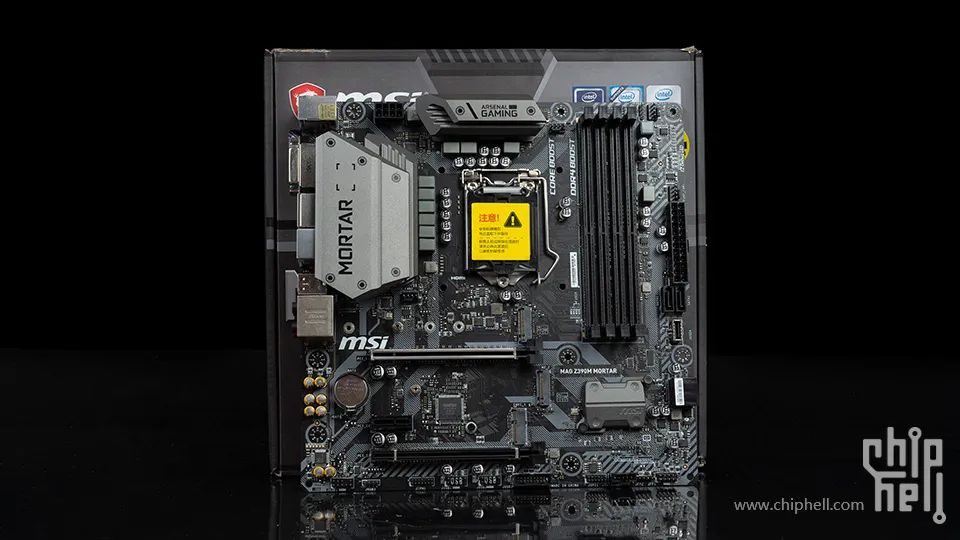 The 9900K is paired with the MSI Z390M MORTAR motherboard. They are clearly not a perfect match, but it’s the only motherboard I have on hand. This motherboard is positioned as a mid-range Z390 option with an 8+2 phase power design, making it a reasonable choice for the 9700K and 9600K.
The 9900K is paired with the MSI Z390M MORTAR motherboard. They are clearly not a perfect match, but it’s the only motherboard I have on hand. This motherboard is positioned as a mid-range Z390 option with an 8+2 phase power design, making it a reasonable choice for the 9700K and 9600K.
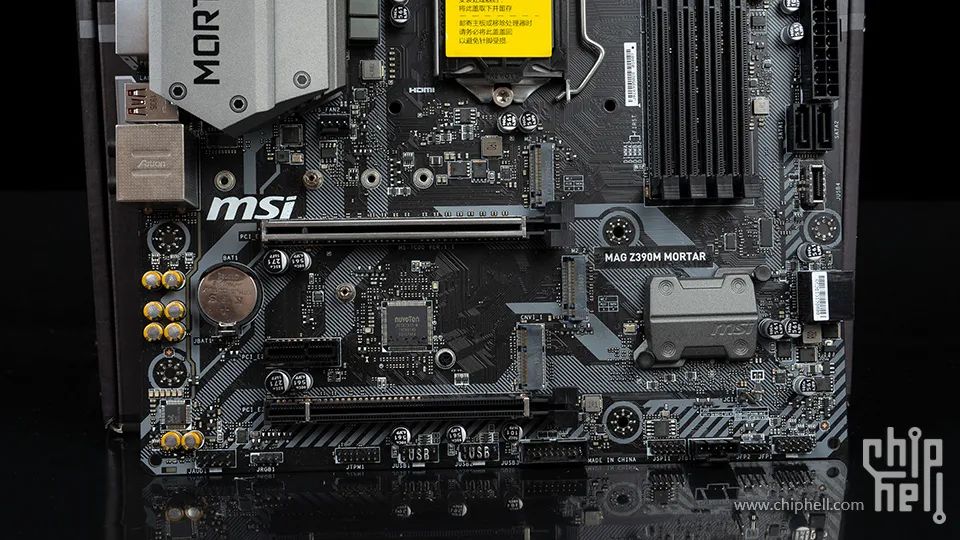 Overall, one notable feature is the inclusion of a front USB 3.1 Gen2 Type-C port (case), which many entry-level Z390 and even Z490 motherboards lack. Looking at the lower area, it has dual M.2 and CNVi wireless module slots, both M.2 slots support PCIe 3.0 x4 full-speed rates, and it includes two 12V 4pin lighting connectors. Aside from the lack of a fancy armor, it offers adequate features.
Overall, one notable feature is the inclusion of a front USB 3.1 Gen2 Type-C port (case), which many entry-level Z390 and even Z490 motherboards lack. Looking at the lower area, it has dual M.2 and CNVi wireless module slots, both M.2 slots support PCIe 3.0 x4 full-speed rates, and it includes two 12V 4pin lighting connectors. Aside from the lack of a fancy armor, it offers adequate features.
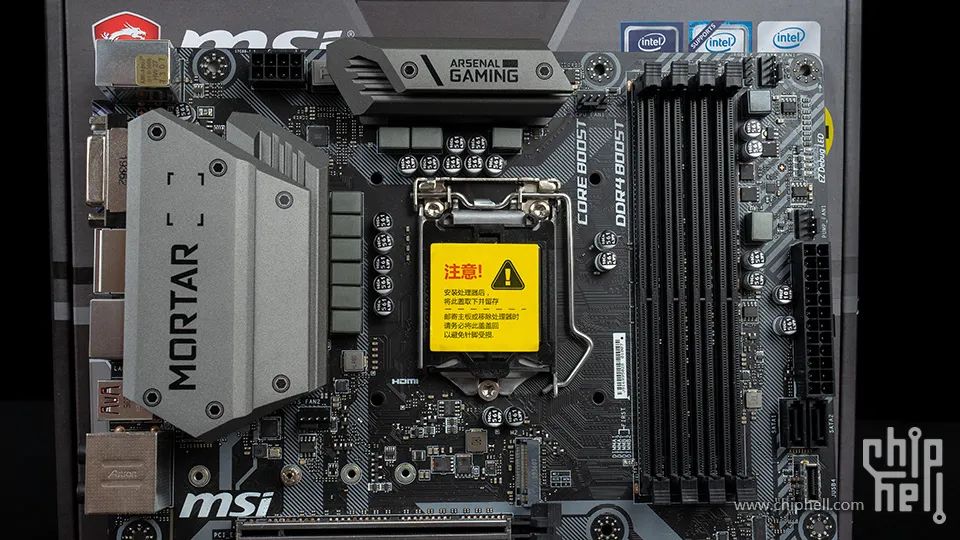 Another model is the Z390M S01, but the MORTAR has a more comprehensive power and cooling design. The maximum memory frequency can be overclocked to 4400MHz, which is a traditional advantage of MSI’s entire product line. Below is the RunMemtest stress test for reference.
Another model is the Z390M S01, but the MORTAR has a more comprehensive power and cooling design. The maximum memory frequency can be overclocked to 4400MHz, which is a traditional advantage of MSI’s entire product line. Below is the RunMemtest stress test for reference.
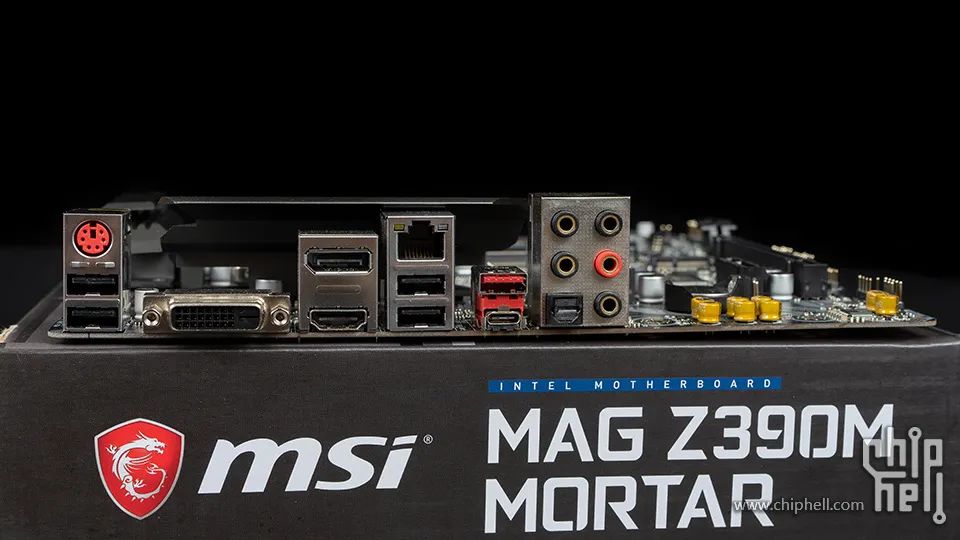 In terms of rear I/O interfaces, it is relatively less abundant, with only one USB 3.1 Gen2 Type A and four USB 2.0 ports. The video output interfaces are quite complete, and retaining the USB 3.1 Gen2 Type-C and S/PDIF audio output interfaces is commendable!
In terms of rear I/O interfaces, it is relatively less abundant, with only one USB 3.1 Gen2 Type A and four USB 2.0 ports. The video output interfaces are quite complete, and retaining the USB 3.1 Gen2 Type-C and S/PDIF audio output interfaces is commendable!
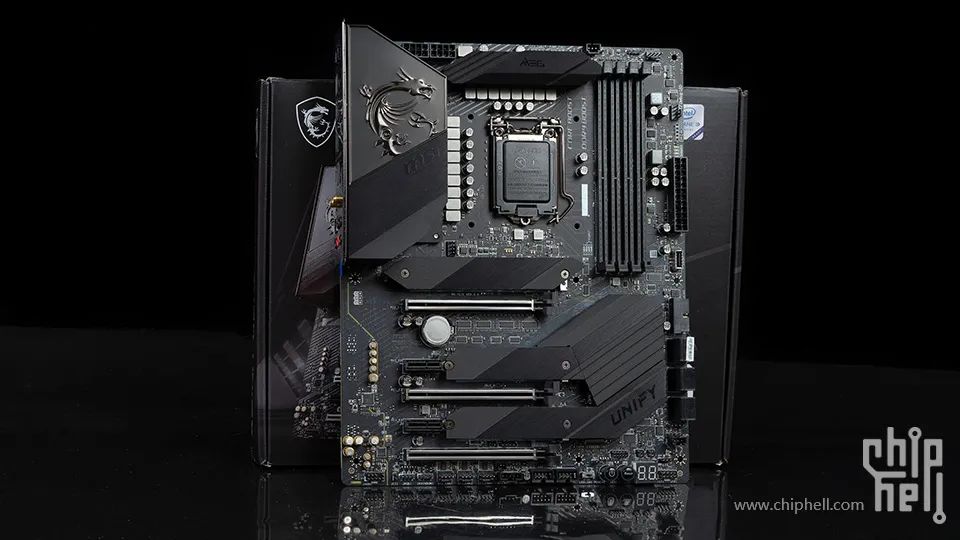 Next is the 10900K’s motherboard, paired with the MSI Z490 UNIFY. It is essentially a non-RGB version of the mid-tier ACE motherboard, with some minor changes in details, such as a more “shadow” color scheme and the complete removal of built-in lighting effects. The main differences are the removal of the metal armor on the memory slots and the absence of a metal backplate, making it slightly weaker under extreme cooling conditions. The shadow board is roughly 500 yuan cheaper.
Next is the 10900K’s motherboard, paired with the MSI Z490 UNIFY. It is essentially a non-RGB version of the mid-tier ACE motherboard, with some minor changes in details, such as a more “shadow” color scheme and the complete removal of built-in lighting effects. The main differences are the removal of the metal armor on the memory slots and the absence of a metal backplate, making it slightly weaker under extreme cooling conditions. The shadow board is roughly 500 yuan cheaper.
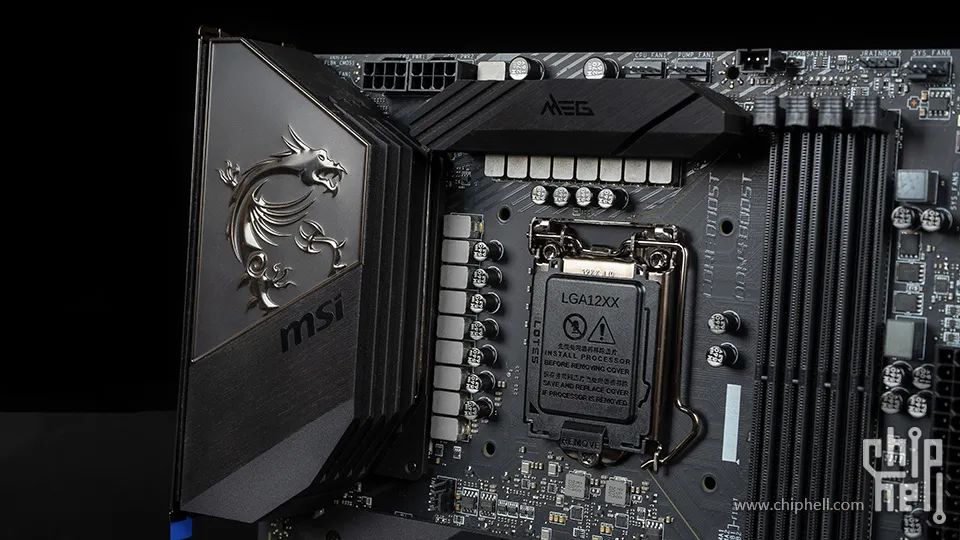 It features 16+1 phase digital power delivery, with each phase capable of supplying a maximum load of 90A current. The dual 8pin external power supply makes it very easy to overclock the 10900K. After all, even its little brother, the dark board, can handle it. The key factor still lies in the CPU’s quality and the motherboard’s optimization. It may be prepared for the next generation flagship. The cooling module for the core power delivery is quite robust, and the MSI’s signature dragon pattern gives it a premium metallic feel, which looks much better than the ACE’s simple design.
It features 16+1 phase digital power delivery, with each phase capable of supplying a maximum load of 90A current. The dual 8pin external power supply makes it very easy to overclock the 10900K. After all, even its little brother, the dark board, can handle it. The key factor still lies in the CPU’s quality and the motherboard’s optimization. It may be prepared for the next generation flagship. The cooling module for the core power delivery is quite robust, and the MSI’s signature dragon pattern gives it a premium metallic feel, which looks much better than the ACE’s simple design.
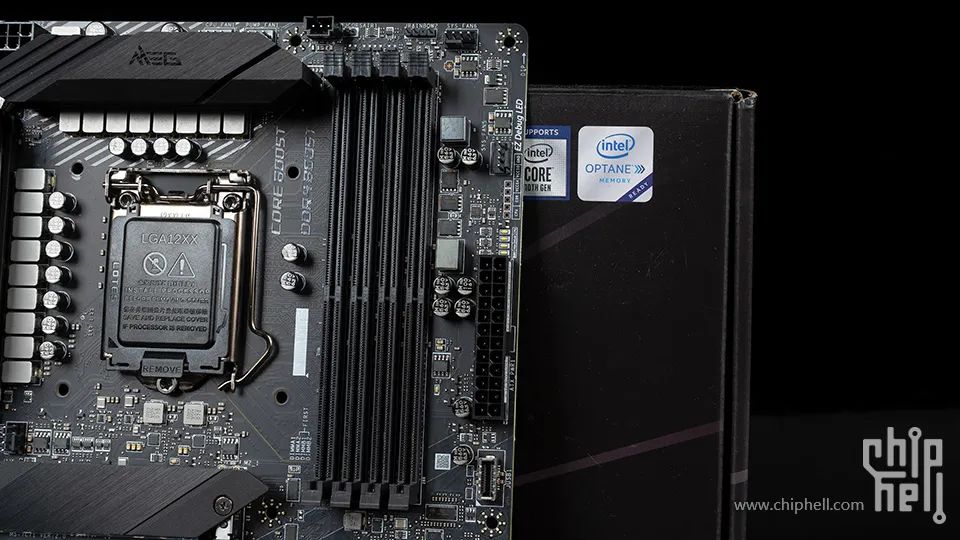 The memory slots support a maximum capacity of 128GB and can be overclocked to 4800MHz, which is a significant improvement compared to the previous generation Z390. This is great news for extreme overclocking enthusiasts. For general gaming, optimizing around 4000MHz is sufficient.
The memory slots support a maximum capacity of 128GB and can be overclocked to 4800MHz, which is a significant improvement compared to the previous generation Z390. This is great news for extreme overclocking enthusiasts. For general gaming, optimizing around 4000MHz is sufficient.
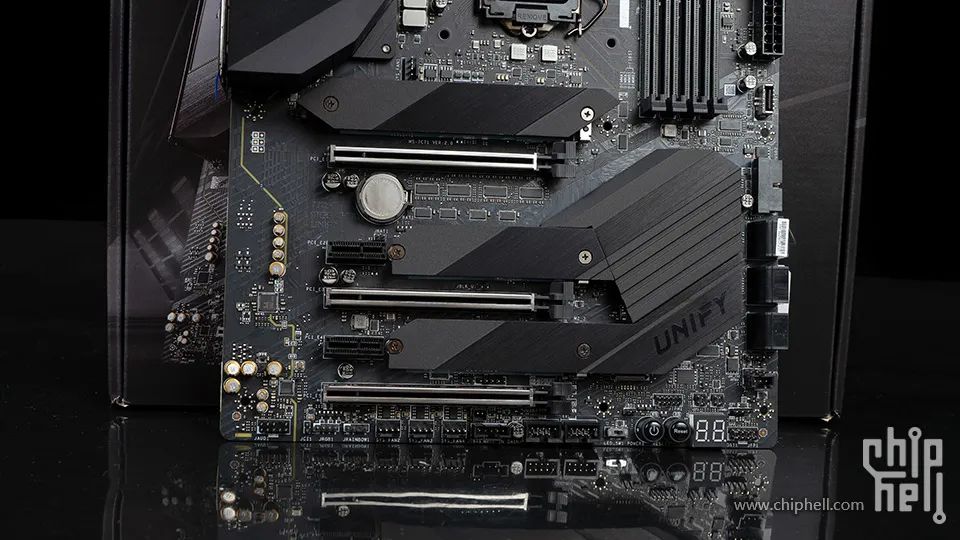 In the lower area, three PCI-EX16 slots are equipped with metal armor, supporting dual SLI or triple CF configurations. As a high-end motherboard, the Z490 UNIFY has a clear advantage with three M.2 slots that support PCIe 3.0 x4 rates, greatly enhancing its expansion capabilities.
In the lower area, three PCI-EX16 slots are equipped with metal armor, supporting dual SLI or triple CF configurations. As a high-end motherboard, the Z490 UNIFY has a clear advantage with three M.2 slots that support PCIe 3.0 x4 rates, greatly enhancing its expansion capabilities.
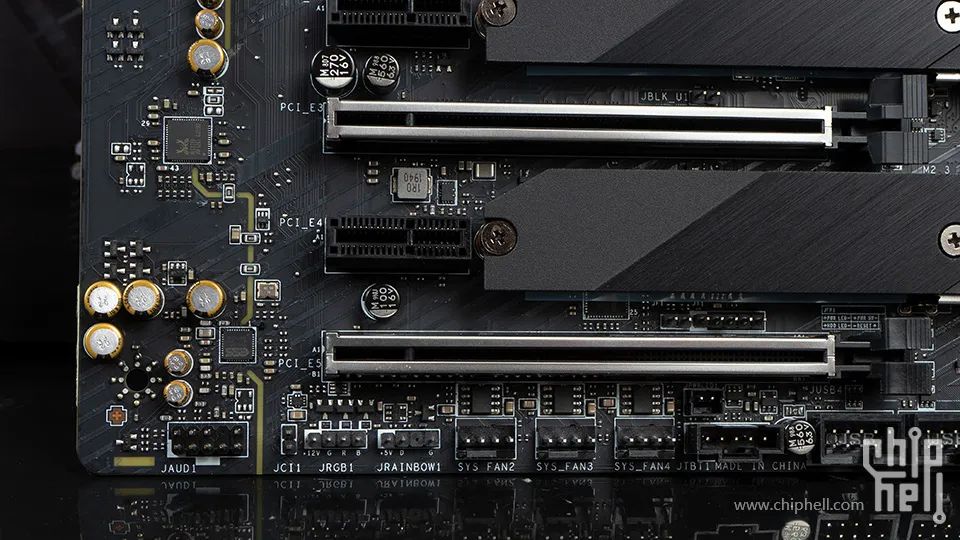 On the left side of the lower area, in addition to the mainstream ALC1220 audio chip, it also supports ESS DAC technology. Furthermore, this motherboard is equipped with two CPU cooler connectors (CPU FAN + PUMP) and six case fan connectors, providing a rich combination that is sufficient for any setup.
On the left side of the lower area, in addition to the mainstream ALC1220 audio chip, it also supports ESS DAC technology. Furthermore, this motherboard is equipped with two CPU cooler connectors (CPU FAN + PUMP) and six case fan connectors, providing a rich combination that is sufficient for any setup.
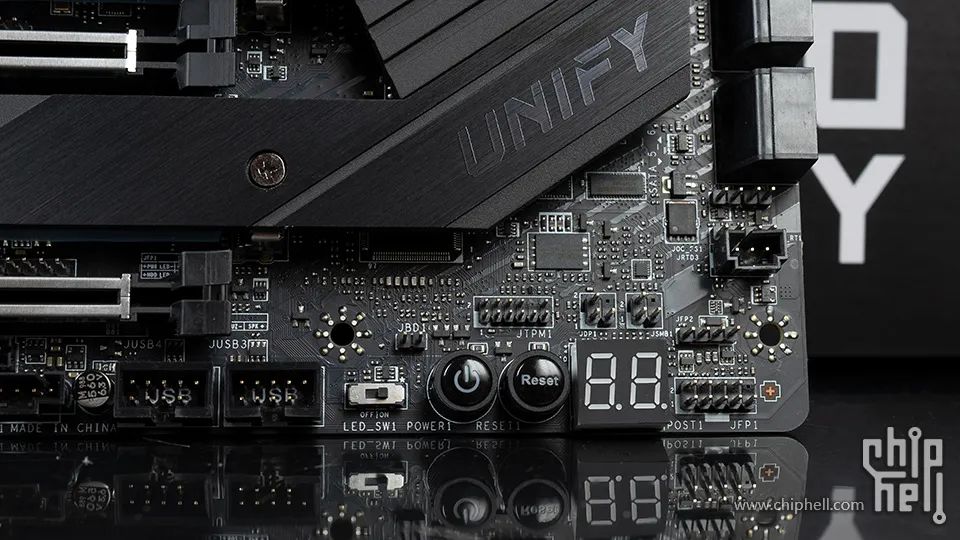 On the right side of the lower area, there are power and reset buttons, as well as a DEBUG light, which looks quite nice. Although the Z490 UNIFY itself lacks lighting, it includes a 12V 4pin, two 5V 3pin, and a Corsair-specific 3pin connector, and provides a total switch for turning the lights on and off in this area.
On the right side of the lower area, there are power and reset buttons, as well as a DEBUG light, which looks quite nice. Although the Z490 UNIFY itself lacks lighting, it includes a 12V 4pin, two 5V 3pin, and a Corsair-specific 3pin connector, and provides a total switch for turning the lights on and off in this area.
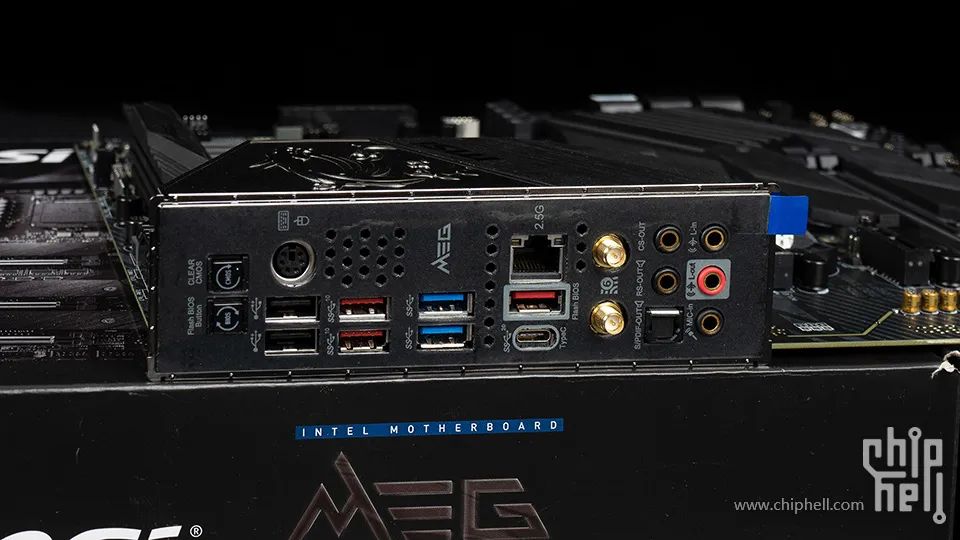 The rear I/O retains the old PS/2 keyboard and mouse ports for the convenience of extreme overclocking enthusiasts. In other aspects, it has a CMOS clear and BIOS update button, various USB ports, especially the USB 3.2 Gen 2×2 Type-C port, which can reach a transfer rate of 20Gbps. The Z490 UNIFY also features upgraded networking equipment, equipped with Intel AX201 wireless Wi-Fi 6 and Realtek 8125B 2.5G wired networking.
The rear I/O retains the old PS/2 keyboard and mouse ports for the convenience of extreme overclocking enthusiasts. In other aspects, it has a CMOS clear and BIOS update button, various USB ports, especially the USB 3.2 Gen 2×2 Type-C port, which can reach a transfer rate of 20Gbps. The Z490 UNIFY also features upgraded networking equipment, equipped with Intel AX201 wireless Wi-Fi 6 and Realtek 8125B 2.5G wired networking.
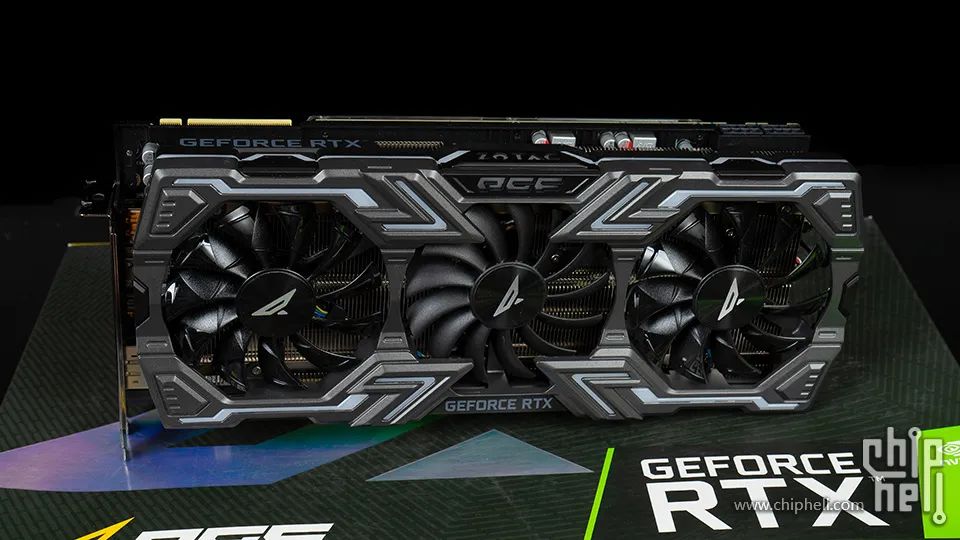 Finally, I must mention this cooling module. Besides being thick, it also features a heat pipe and a mini cooling fan. The MOS fan is generally installed via a bracket, but the Z490 UNIFY’s design is hidden internally.
Finally, I must mention this cooling module. Besides being thick, it also features a heat pipe and a mini cooling fan. The MOS fan is generally installed via a bracket, but the Z490 UNIFY’s design is hidden internally.
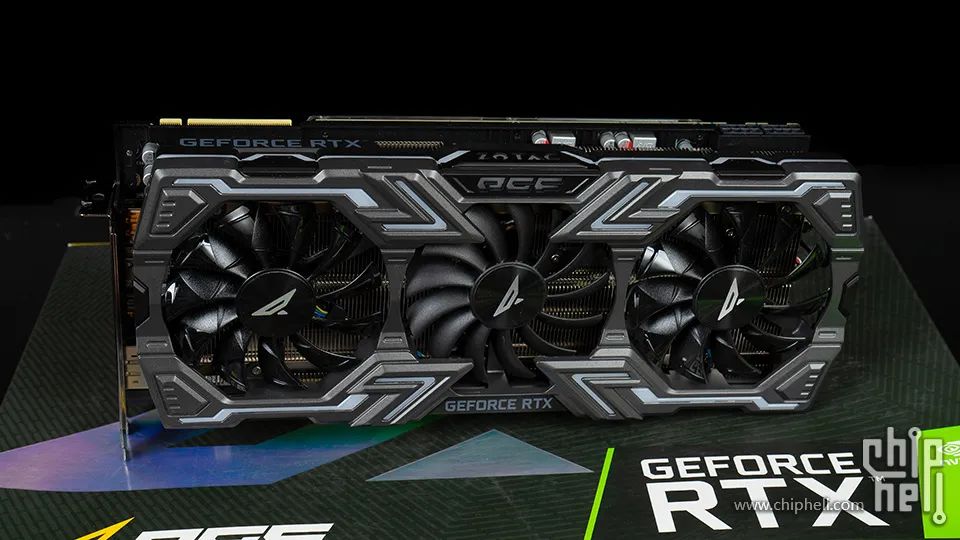 Next is the graphics card. This time we chose the Zotac RTX 2080 Ti Player’s Power Supreme PGF OC14, which is a top-tier flagship product. Its appearance indeed matches the title of “Stacked Materials King” and exudes a strong sense of power, also living up to the nickname “Pork Chop Rice.” The RGB lighting is embedded in the edge area, along with the ZOTAC and PGF logos, covering a large area.
Next is the graphics card. This time we chose the Zotac RTX 2080 Ti Player’s Power Supreme PGF OC14, which is a top-tier flagship product. Its appearance indeed matches the title of “Stacked Materials King” and exudes a strong sense of power, also living up to the nickname “Pork Chop Rice.” The RGB lighting is embedded in the edge area, along with the ZOTAC and PGF logos, covering a large area.
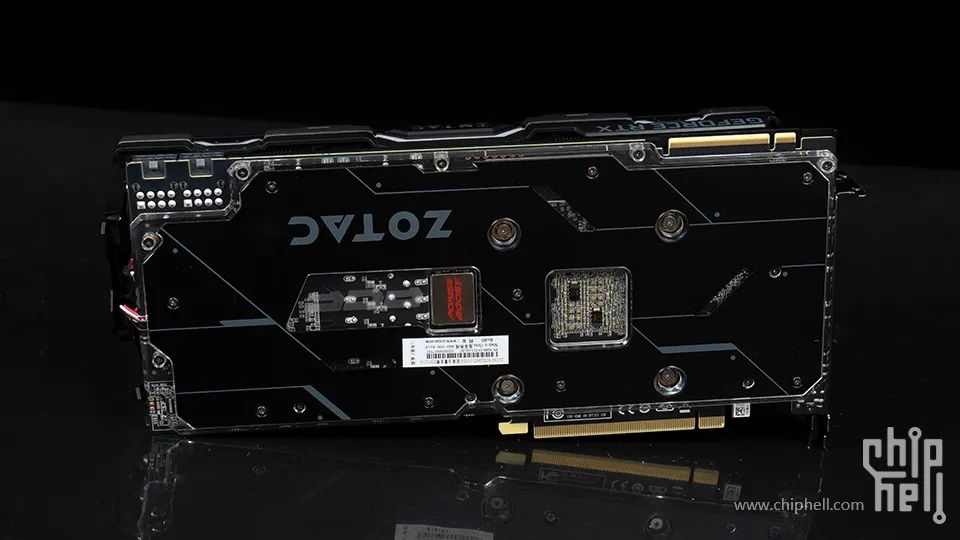 The backplate is equipped with RGB support for 16 million colors, with an acrylic interior and a metal exterior. While other manufacturers focus on the backplate, Zotac has created a unique RGB design in the edge area. The Power Boost chip on the back PCB is a traditional feature of Zotac, enhancing power stability even further.
The backplate is equipped with RGB support for 16 million colors, with an acrylic interior and a metal exterior. While other manufacturers focus on the backplate, Zotac has created a unique RGB design in the edge area. The Power Boost chip on the back PCB is a traditional feature of Zotac, enhancing power stability even further.
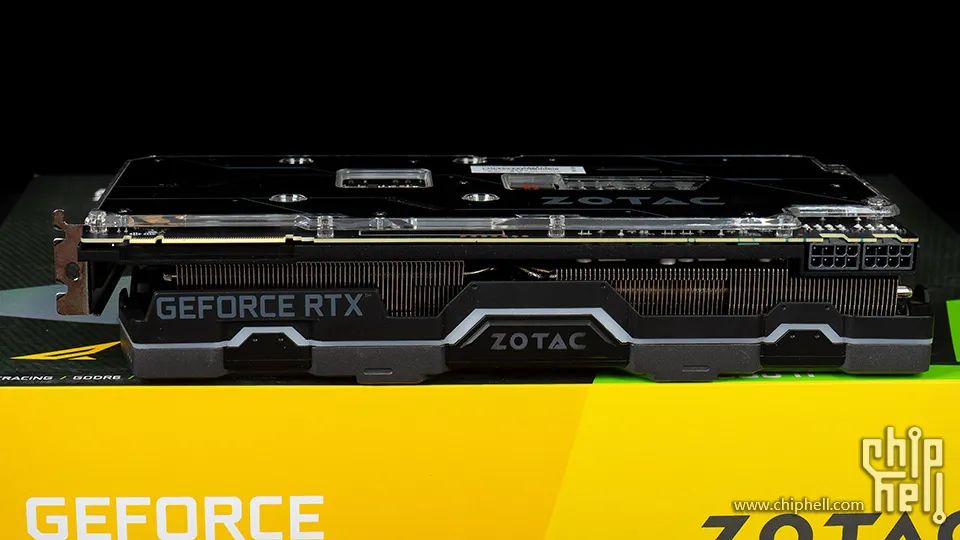 The dual 8pin external power supply is basically standard for the RTX 2080 Ti. From the side, it can be seen that the PGF OC14 has a metal frame between the PCB and the cooling fins, which enhances the overall structural strength and aids in cooling the entire PCB.
The dual 8pin external power supply is basically standard for the RTX 2080 Ti. From the side, it can be seen that the PGF OC14 has a metal frame between the PCB and the cooling fins, which enhances the overall structural strength and aids in cooling the entire PCB.
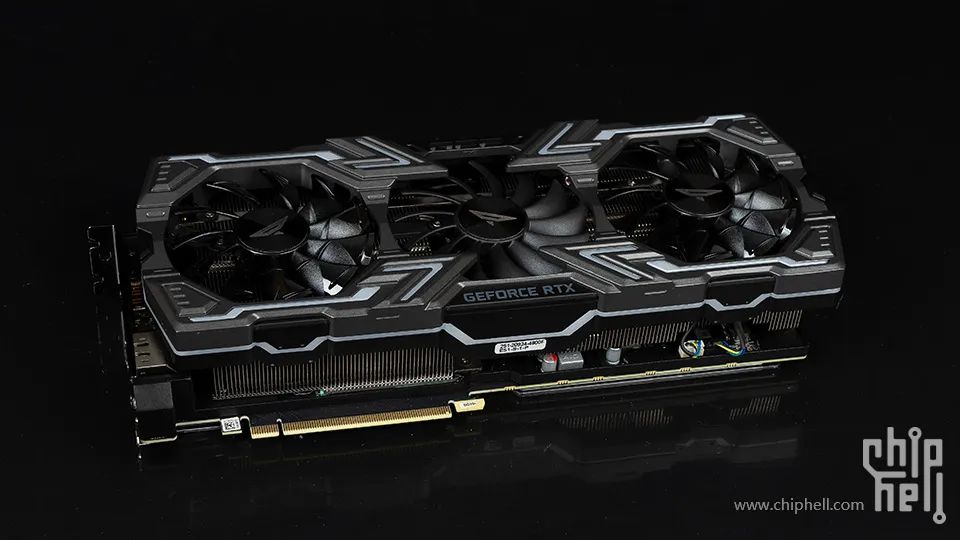 The PGF OC14 is equipped with three 9cm fans, and the screw holes are fully exposed, making it easier to clean dust. The fans can also be completely removed.
The PGF OC14 is equipped with three 9cm fans, and the screw holes are fully exposed, making it easier to clean dust. The fans can also be completely removed.
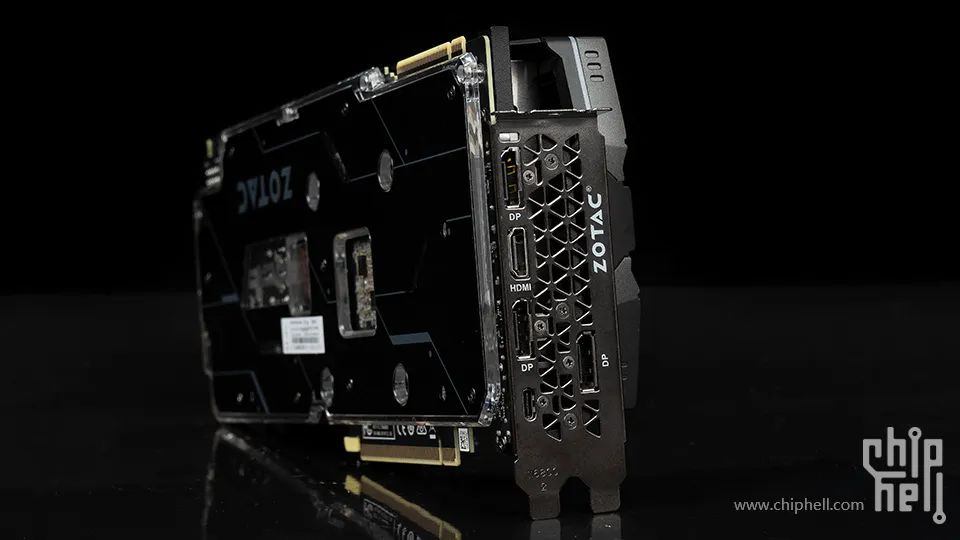 The video output interfaces remain unchanged from the reference design, featuring DP×3, HDMI×1, and USB-C×1. Additionally, from this angle, it can be seen that the PGF OC14’s thickness is approximately at the three-slot level.
The video output interfaces remain unchanged from the reference design, featuring DP×3, HDMI×1, and USB-C×1. Additionally, from this angle, it can be seen that the PGF OC14’s thickness is approximately at the three-slot level.
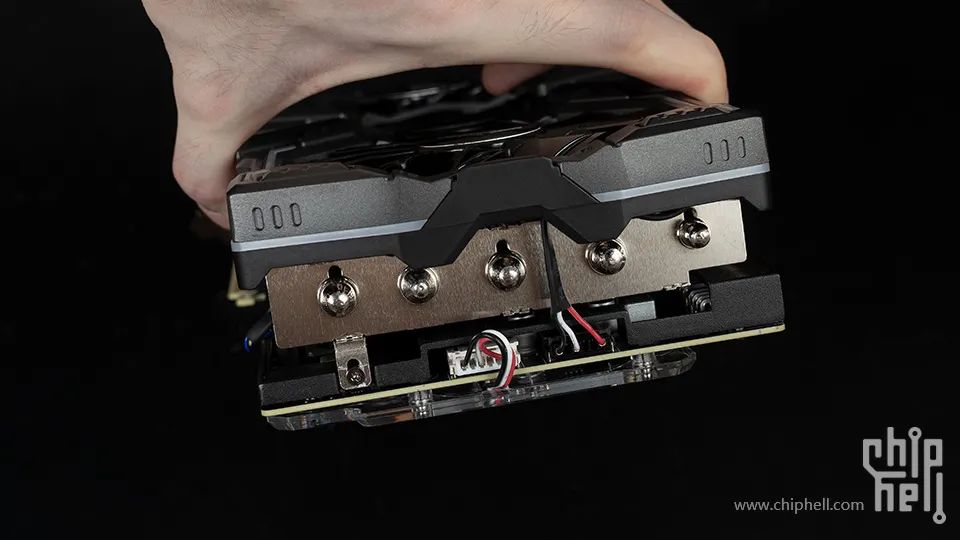 The heat pipe configuration consists of five 8mm and one 6mm pipes, combined with a large area of fins and three 9cm fans, providing excellent cooling performance. The specific results will be shown in the subsequent tests.
The heat pipe configuration consists of five 8mm and one 6mm pipes, combined with a large area of fins and three 9cm fans, providing excellent cooling performance. The specific results will be shown in the subsequent tests.
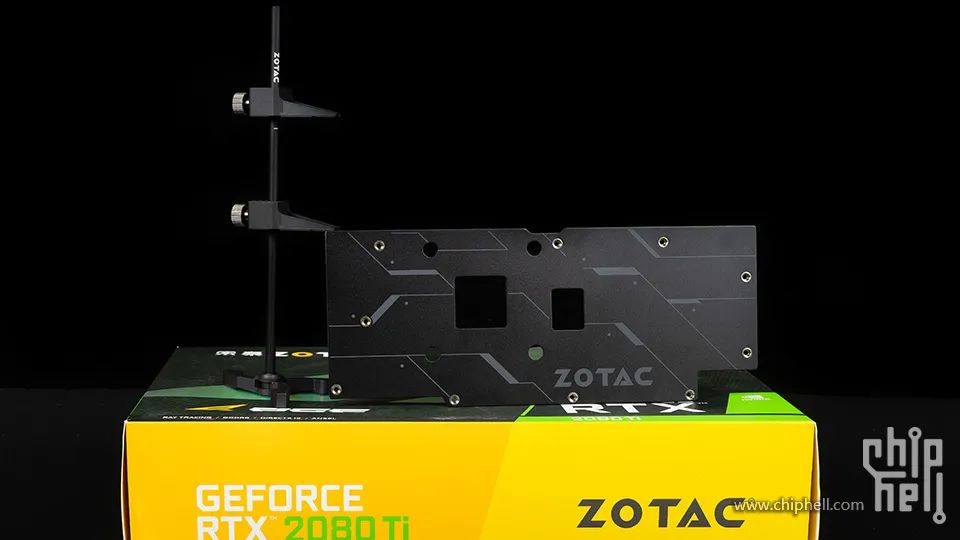 In terms of accessories, aside from a bunch of papers and manuals, the most practical items are the replaceable metal backplate and the graphics card support bracket. The former can selectively reduce light pollution and assist with cooling, while the latter is essential for such a “Stacked Materials King” level card to prevent sagging.
In terms of accessories, aside from a bunch of papers and manuals, the most practical items are the replaceable metal backplate and the graphics card support bracket. The former can selectively reduce light pollution and assist with cooling, while the latter is essential for such a “Stacked Materials King” level card to prevent sagging.
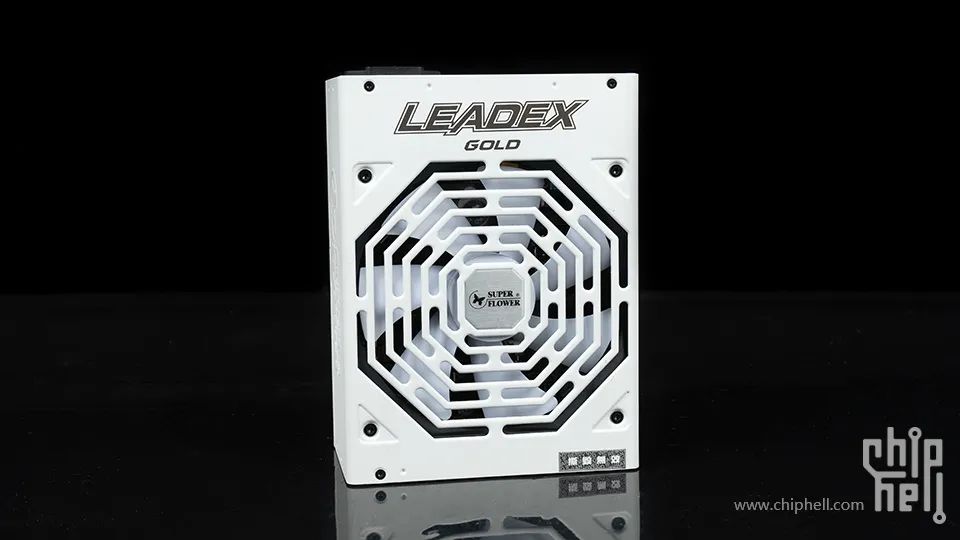 To power a top-tier configuration like the 10900K + RTX 2080 Ti, a good power supply is essential. Theoretically, 850W is sufficient, but having more headroom is obviously better. Here, we have chosen the Super Flower LEADEX G 1000W, which not only has a rare all-white aesthetic in the PC industry (there is also a black version), but Super Flower itself is a well-established power supply manufacturer and a supplier for many brands, plus it comes with a 10-year warranty.
To power a top-tier configuration like the 10900K + RTX 2080 Ti, a good power supply is essential. Theoretically, 850W is sufficient, but having more headroom is obviously better. Here, we have chosen the Super Flower LEADEX G 1000W, which not only has a rare all-white aesthetic in the PC industry (there is also a black version), but Super Flower itself is a well-established power supply manufacturer and a supplier for many brands, plus it comes with a 10-year warranty.
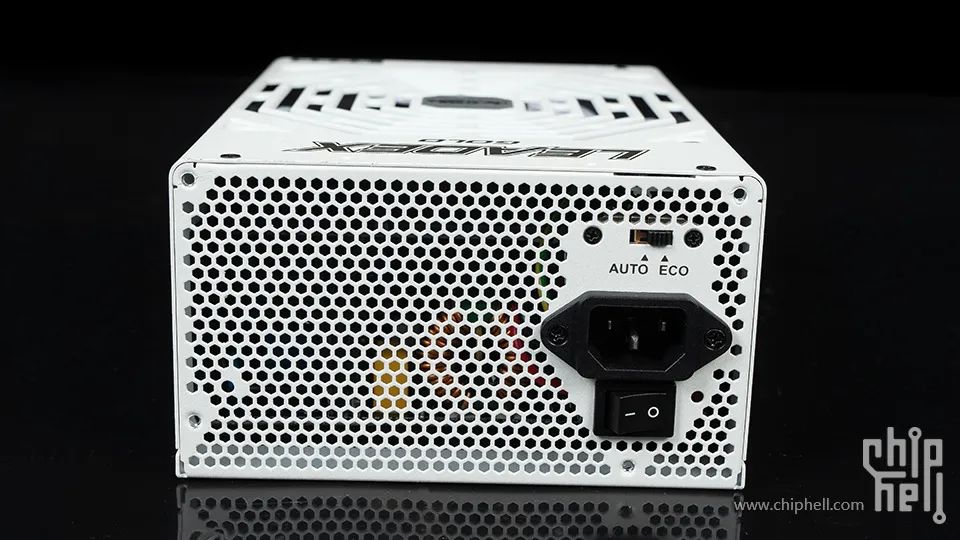 The LEADEX G 1000W supports ECO energy-saving temperature control. With this small switch, players can choose between silent or cooling priority modes, a hallmark feature of most mid-to-high-end power supplies.
The LEADEX G 1000W supports ECO energy-saving temperature control. With this small switch, players can choose between silent or cooling priority modes, a hallmark feature of most mid-to-high-end power supplies.
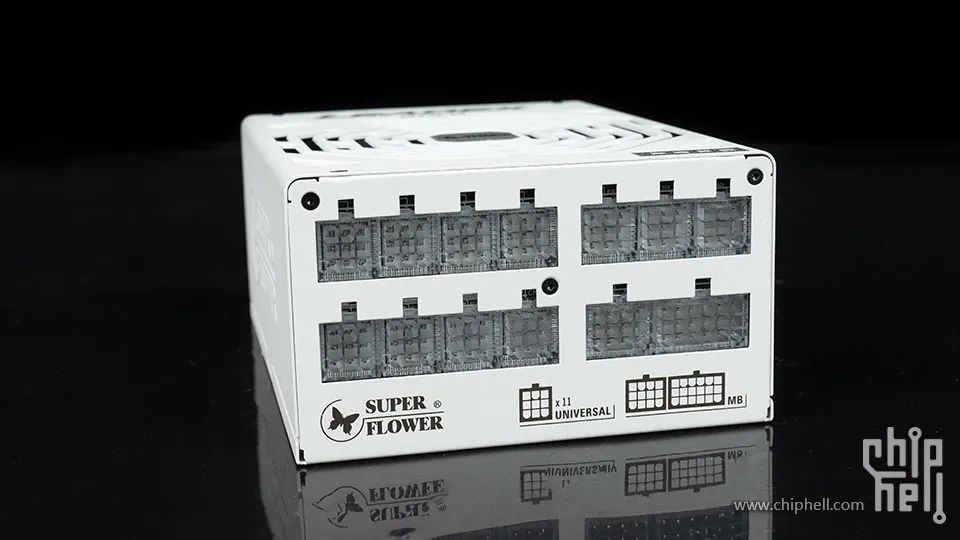 The entire LEADEX G series adopts Super Flower’s unique grid module interface. Aside from the motherboard cables, all others are universal, making wiring and cable management much easier. Additionally, the connectors are designed with transparent crystals, emitting a white glow when in use. The LEADEX G is one of the earliest products to focus on lighting effects in power supplies.
The entire LEADEX G series adopts Super Flower’s unique grid module interface. Aside from the motherboard cables, all others are universal, making wiring and cable management much easier. Additionally, the connectors are designed with transparent crystals, emitting a white glow when in use. The LEADEX G is one of the earliest products to focus on lighting effects in power supplies.
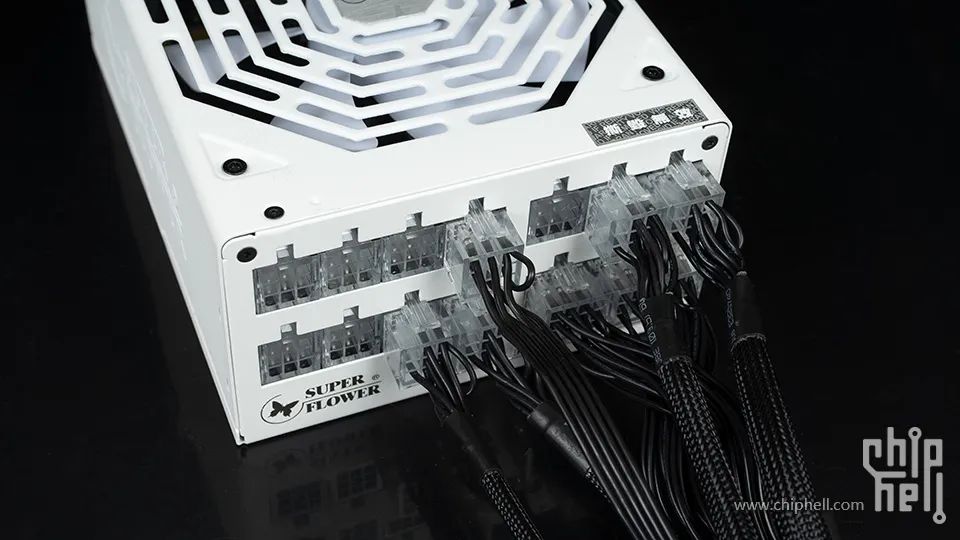 The power supply uses a mainstream LLC half-bridge + DC-DC architecture, with Japanese capacitors and customized Infineon MOSFETs. It is a fully modular 1000W 80PLUS Gold unit, capable of delivering 999.6W output power on a single +12V rail, and has a conversion efficiency of 91.23%, which is close to Platinum certification. Its length reaches 200mm, so compatibility should be considered during installation.
The power supply uses a mainstream LLC half-bridge + DC-DC architecture, with Japanese capacitors and customized Infineon MOSFETs. It is a fully modular 1000W 80PLUS Gold unit, capable of delivering 999.6W output power on a single +12V rail, and has a conversion efficiency of 91.23%, which is close to Platinum certification. Its length reaches 200mm, so compatibility should be considered during installation.
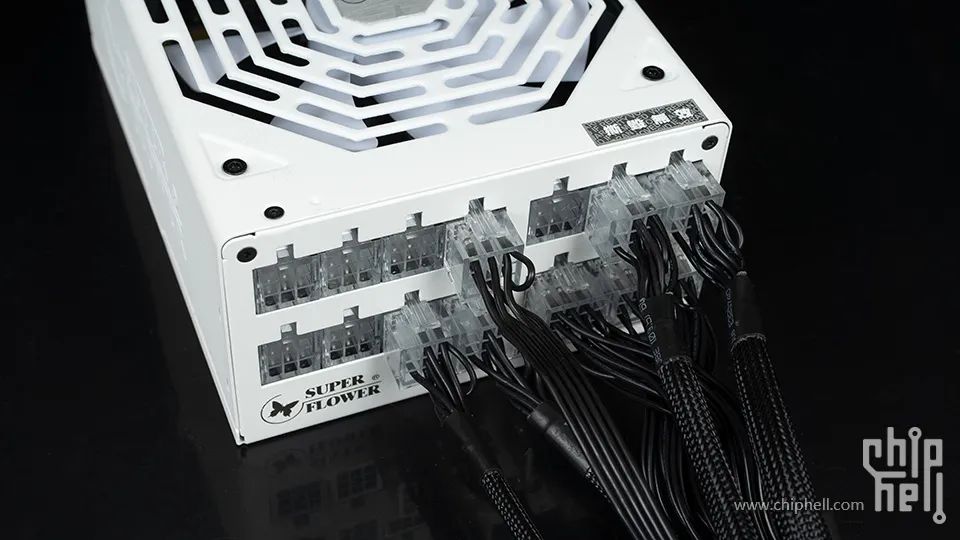 The modular cable power supply features a crystal head design, making the connectors universal and very convenient. The only downside is that when unplugging, the connectors tend to be quite tight.
The modular cable power supply features a crystal head design, making the connectors universal and very convenient. The only downside is that when unplugging, the connectors tend to be quite tight.
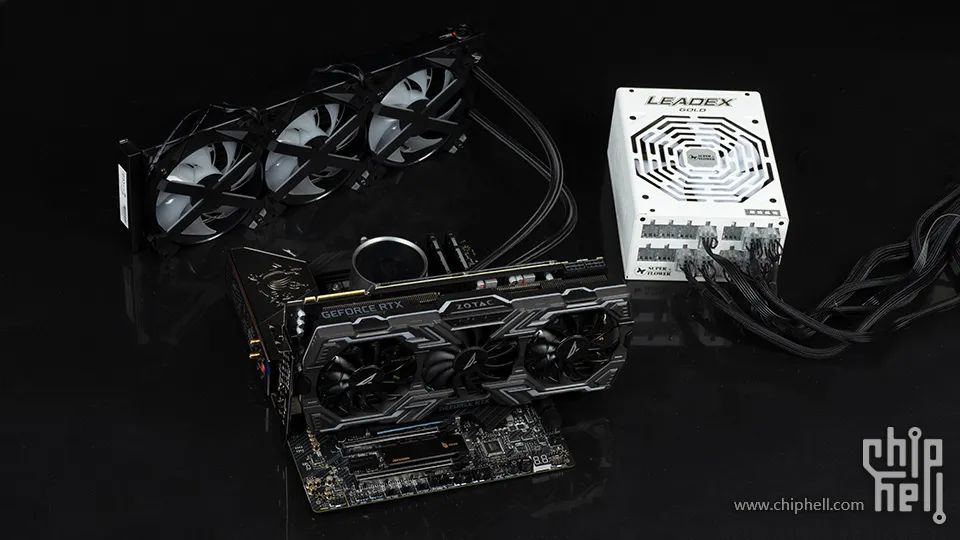 Alright, with the entire setup ready, let’s briefly introduce the other hardware. The all-in-one water cooler used is the Deepcool Castle 360EX RGB, the memory is Kingston Predator DDR4-3600 8GBX2, and the SSD is a combination of Hikvision C2000 PRO + Samsung PM 981.
Alright, with the entire setup ready, let’s briefly introduce the other hardware. The all-in-one water cooler used is the Deepcool Castle 360EX RGB, the memory is Kingston Predator DDR4-3600 8GBX2, and the SSD is a combination of Hikvision C2000 PRO + Samsung PM 981.
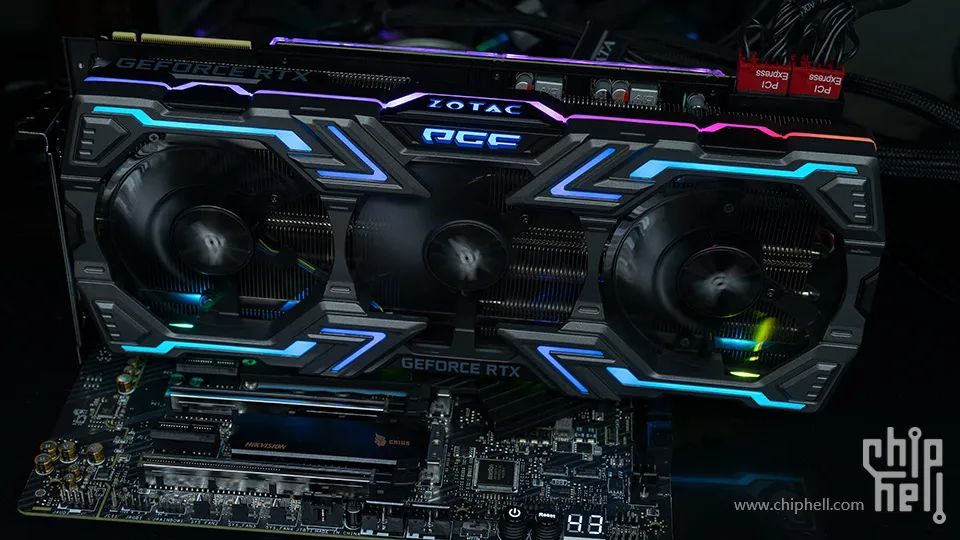 The lighting effect of the Zotac RTX 2080 Ti PGF OC14 is quite natural and beautiful, while the Z490 UNIFY has no built-in lighting effects.
The lighting effect of the Zotac RTX 2080 Ti PGF OC14 is quite natural and beautiful, while the Z490 UNIFY has no built-in lighting effects.
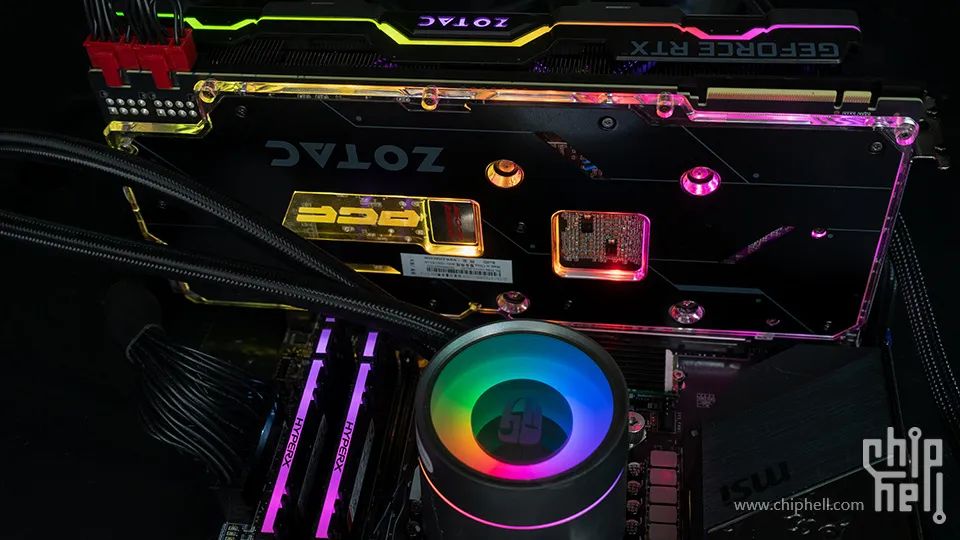 The back lighting effect is equally outstanding. For those pursuing cooling performance, a pure metal backplate can be swapped in, while the Castle 360EX RGB and Predator…
The back lighting effect is equally outstanding. For those pursuing cooling performance, a pure metal backplate can be swapped in, while the Castle 360EX RGB and Predator…
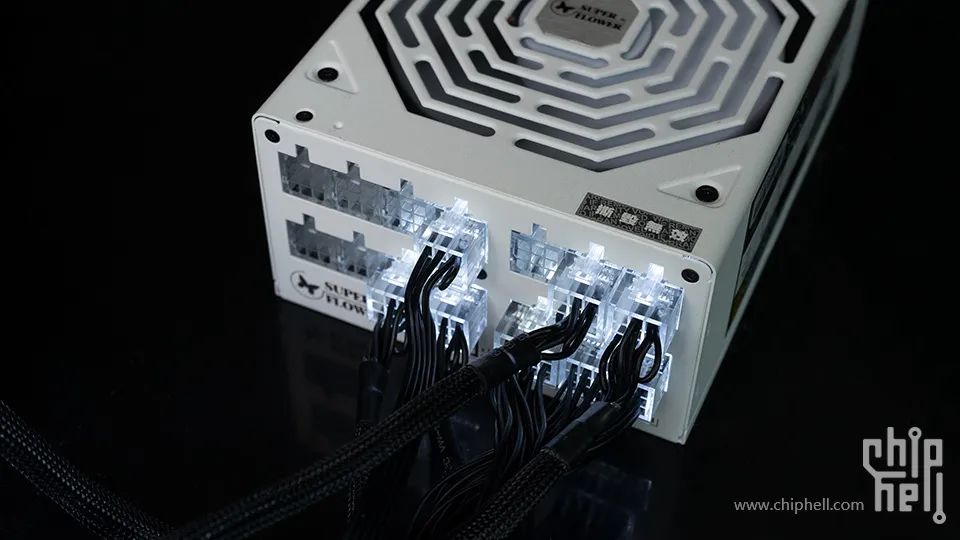 The Super Flower LEADEX G 1000W does not light up if not connected.
The Super Flower LEADEX G 1000W does not light up if not connected.
Theory, overclocking, and high-load comparison
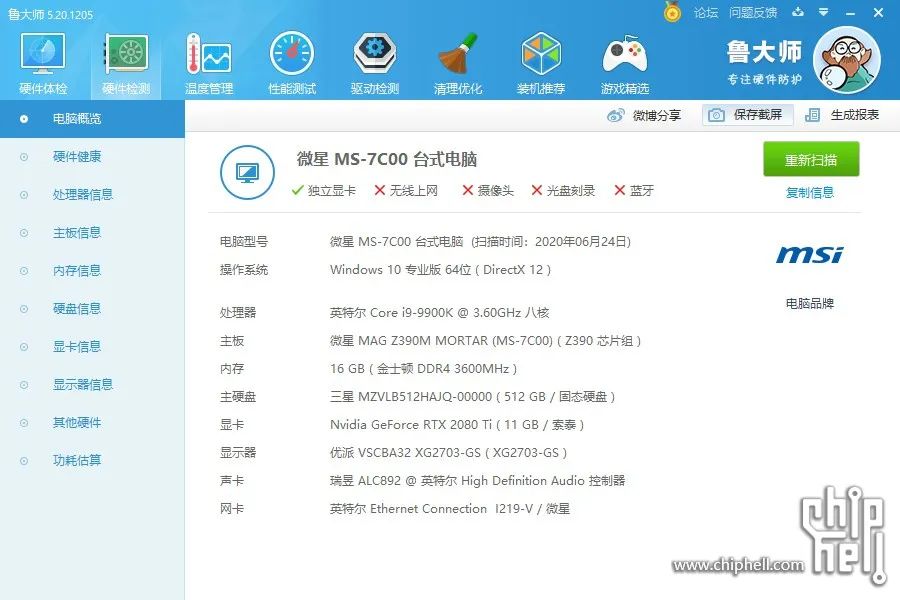 9900K Platform
9900K Platform
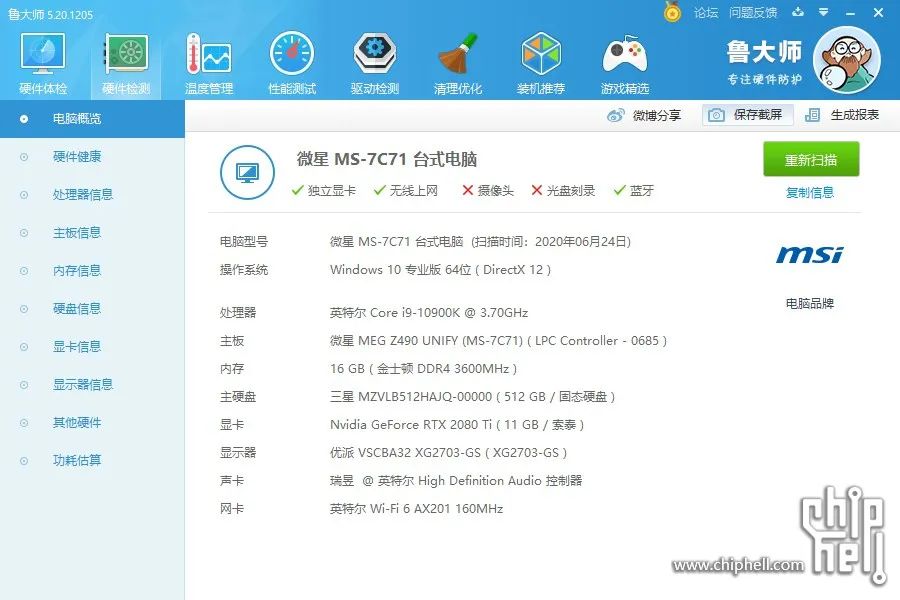 10900K Platform
10900K Platform
The results from the benchmarking software show that both configurations share the same SSD, running Windows 10 version 1909, with NVIDIA 446.14 WHQL graphics drivers, and using the ViewSonic XG2703-GS monitor set to 2K resolution with G-SYNC turned off.
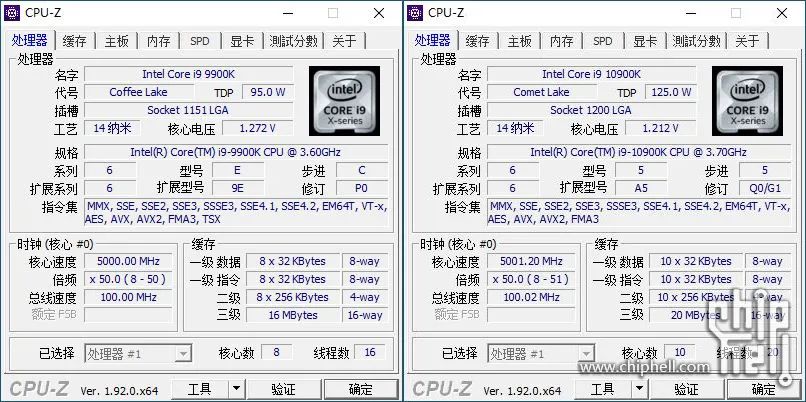 For the default frequency, we will skip it. Both CPUs were overclocked to a full core 5.0GHz, which should be easily achievable for both. Aside from the differences in core count, thread count, and L3 cache, everything else is essentially the same. Upon closer comparison, the 10900K lacks the TSX instruction set, which is not used by most newer emulators, unless they are older versions.
For the default frequency, we will skip it. Both CPUs were overclocked to a full core 5.0GHz, which should be easily achievable for both. Aside from the differences in core count, thread count, and L3 cache, everything else is essentially the same. Upon closer comparison, the 10900K lacks the TSX instruction set, which is not used by most newer emulators, unless they are older versions.
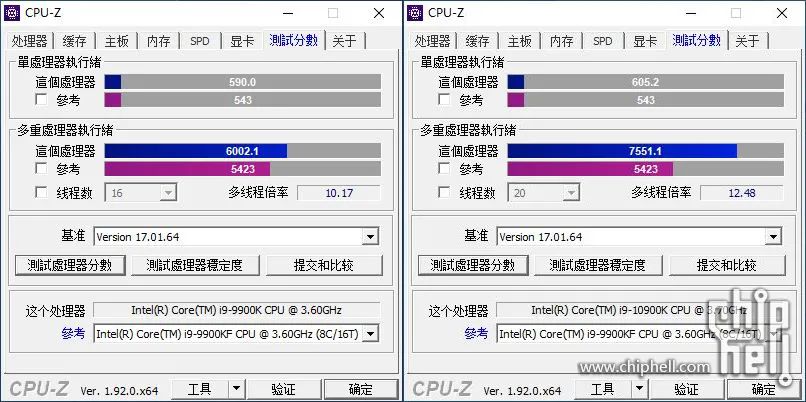 The CPU-Z benchmark results show that after running three consecutive tests, the 10900K’s multi-core performance is improved by 25% compared to the 9900K, while the single-core performance has a roughly 2% improvement after extensive optimization.
The CPU-Z benchmark results show that after running three consecutive tests, the 10900K’s multi-core performance is improved by 25% compared to the 9900K, while the single-core performance has a roughly 2% improvement after extensive optimization.
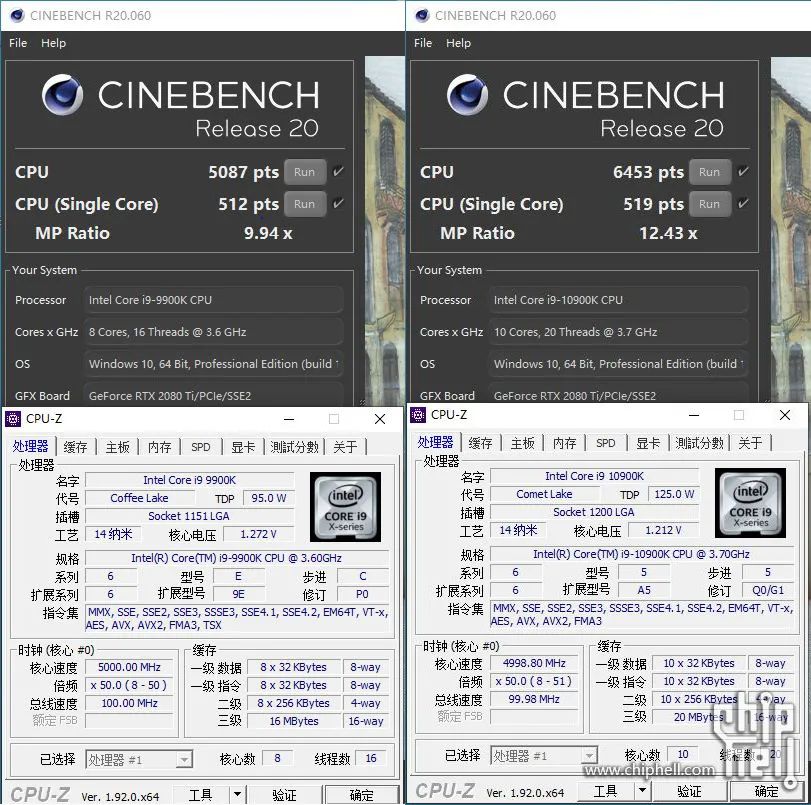 In the CINBENCH R20 benchmark, the 10900K shows a similar level of improvement compared to the 9900K, reflecting comparable performance in productivity software that relies heavily on more cores and hyper-threading technology, while also benefiting from single-core performance. The ten-core twenty-thread setup is sufficient for the Adobe Creative Cloud suite, so consumers who need both content creation and gaming performance are still willing to spend a bit more on the 10900K, especially game streamers.
In the CINBENCH R20 benchmark, the 10900K shows a similar level of improvement compared to the 9900K, reflecting comparable performance in productivity software that relies heavily on more cores and hyper-threading technology, while also benefiting from single-core performance. The ten-core twenty-thread setup is sufficient for the Adobe Creative Cloud suite, so consumers who need both content creation and gaming performance are still willing to spend a bit more on the 10900K, especially game streamers.
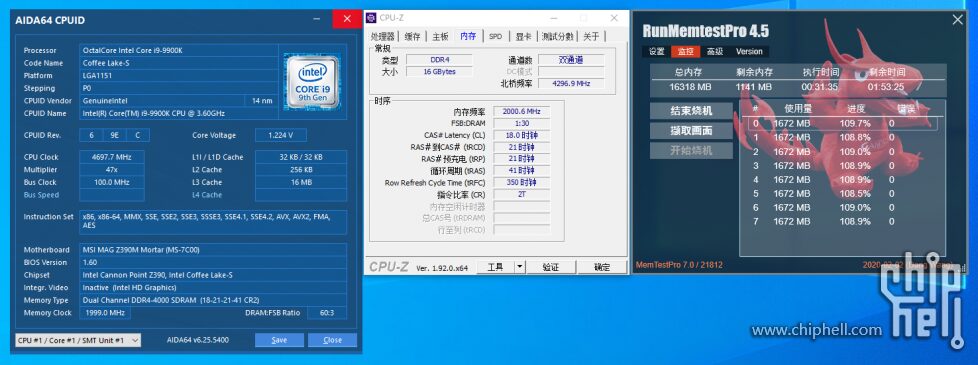 The Kingston Predator DDR4-3600 was overclocked to 4000 C18-21-21-41, with the 9900K + Z390M MORTAR achieving this through 100% MT.
The Kingston Predator DDR4-3600 was overclocked to 4000 C18-21-21-41, with the 9900K + Z390M MORTAR achieving this through 100% MT.
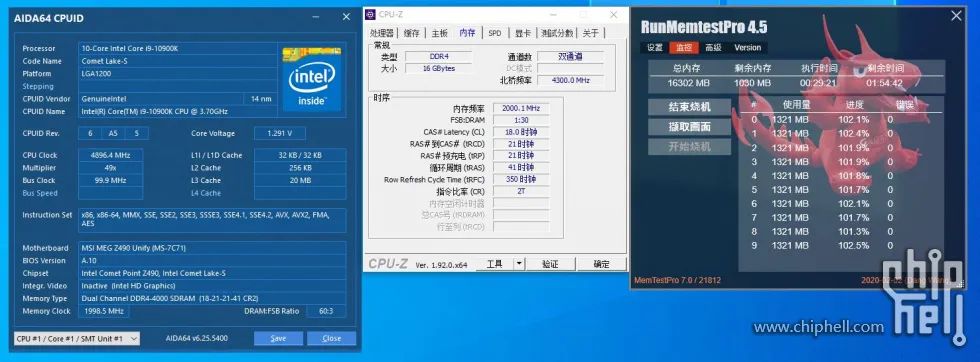 The Kingston Predator DDR4-3600 was overclocked to 4000 C18-21-21-41, with the 10900K + Z490 UNIFY also achieving this through 100% MT.
The Kingston Predator DDR4-3600 was overclocked to 4000 C18-21-21-41, with the 10900K + Z490 UNIFY also achieving this through 100% MT.
The conservative timing settings align with those of regular users. In fact, the later versions of the Predator memory are generally not as good. Both motherboards can easily pass simple stress tests at DDR4-4000.
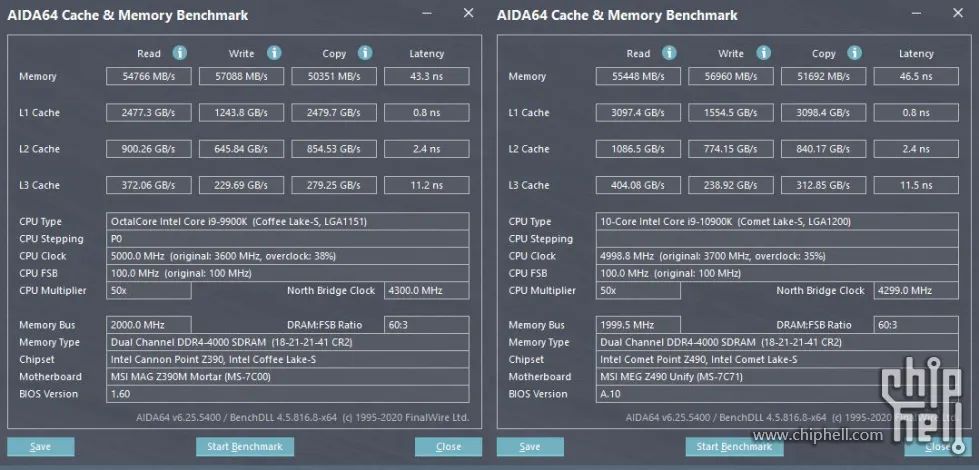 The AIDA64 memory and cache tests reveal that even with the same memory, the 10900K’s latency is higher than that of the 9900K, as it is already at the limit of the ring bus.
The AIDA64 memory and cache tests reveal that even with the same memory, the 10900K’s latency is higher than that of the 9900K, as it is already at the limit of the ring bus.
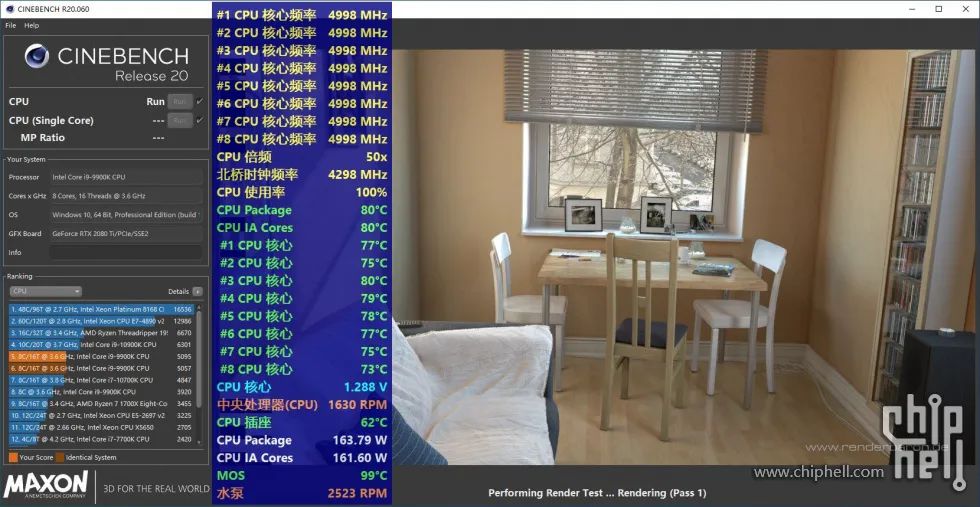 The 9900K overclocked to a full core 5GHz requires around 1.29V core voltage (previously, the 9900KF needed 1.32V for FPU), which is considered normal for its class (1.25V would be considered a bit of a gem for the 9th generation). Due to the motherboard’s power specifications, it could only run a single round of CINEBENCH R20; continuous runs would push the MOS temperature above 100℃, leading to throttling. Towards the end of the test, the CPU Package temperature reached 80℃, which would be even higher during AIDA64 FPU projects, with power consumption around 190W.
The 9900K overclocked to a full core 5GHz requires around 1.29V core voltage (previously, the 9900KF needed 1.32V for FPU), which is considered normal for its class (1.25V would be considered a bit of a gem for the 9th generation). Due to the motherboard’s power specifications, it could only run a single round of CINEBENCH R20; continuous runs would push the MOS temperature above 100℃, leading to throttling. Towards the end of the test, the CPU Package temperature reached 80℃, which would be even higher during AIDA64 FPU projects, with power consumption around 190W.
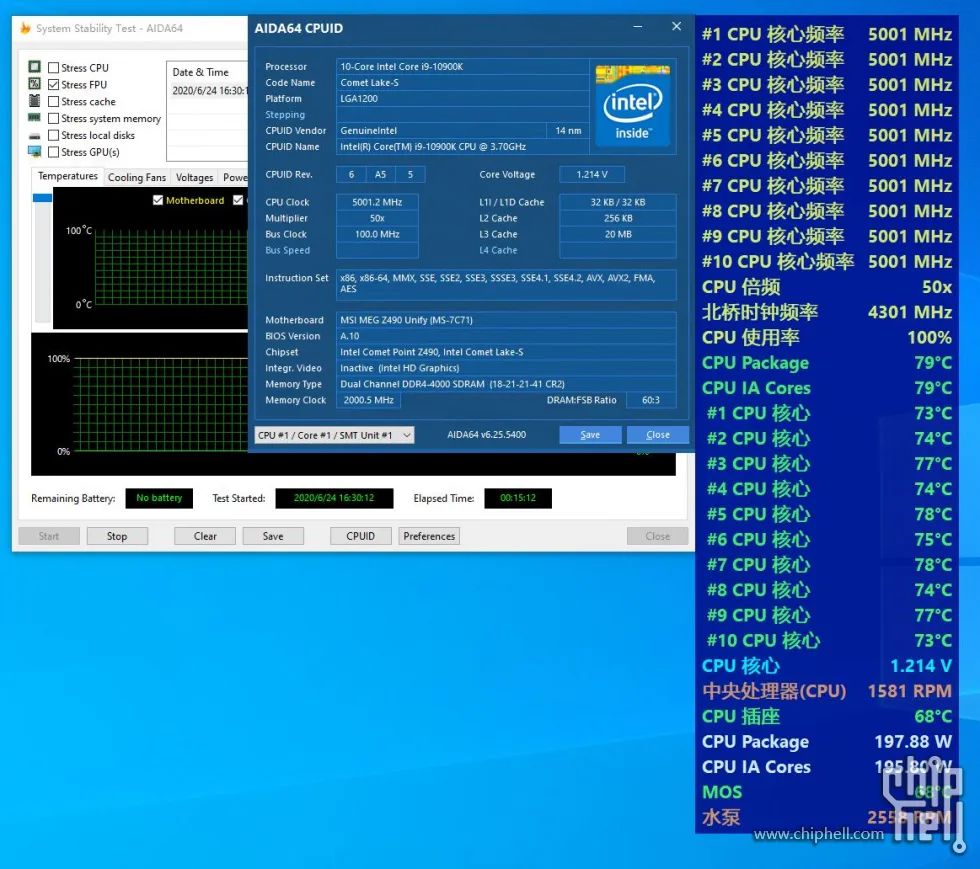 In contrast, the 10900K’s AIDA64 FPU requires only 1.214V to run, with the CPU Package temperature at only 79℃, surprisingly similar to the 9900K’s R20 performance. In reality, the 10th generation Core K series not only optimizes at the die level but also shows generally better quality. In other words, the temperature and power consumption are more favorable. I have tested two 10900Ks and one 10700K, and they all easily pass full-core 5GHz stress tests around 1.2V, while reaching 5.2GHz becomes quite difficult, typically requiring a gem-level chip.
In contrast, the 10900K’s AIDA64 FPU requires only 1.214V to run, with the CPU Package temperature at only 79℃, surprisingly similar to the 9900K’s R20 performance. In reality, the 10th generation Core K series not only optimizes at the die level but also shows generally better quality. In other words, the temperature and power consumption are more favorable. I have tested two 10900Ks and one 10700K, and they all easily pass full-core 5GHz stress tests around 1.2V, while reaching 5.2GHz becomes quite difficult, typically requiring a gem-level chip.
As usual, we ran 3DMark to validate the graphics card performance. The Zotac RTX 2080 Ti PGF OC14 scored 35492 in the Fire Strike project, leading the reference design scores. Its claimed BOOST frequency is 1755MHz, but it can actually reach around 1850 to 1900MHz, with a maximum core temperature of 73℃. The fan noise is also quite low, only below 2000RPM.
Since the Zotac RTX 2080 Ti PGF OC14 adopts a 16+4 phase power design, overclocking is also possible. The core frequency can be pushed up by 160MHz to reach 1915MHz, while the memory frequency can be increased from 1850MHz to 2000MHz (equivalent to 16Gbps). It can pass the Fire Strike project, with the highest operating frequency reaching 2115MHz, resulting in a 9% increase in graphics score compared to default settings.
Testing Games at Same Frequency and with Hyper-Threading Disabled
It’s time for the gaming segment, where most CPU comparison tests are conducted at 1080P to highlight performance differences. However, the reality is that most users purchasing the 10900K and 9900K would pair them with graphics cards above the RTX 2080 SUPER, typically at 2K resolution (while 4K cards would bottleneck). Therefore, this time we are conducting an unprecedented 2K resolution comparison.
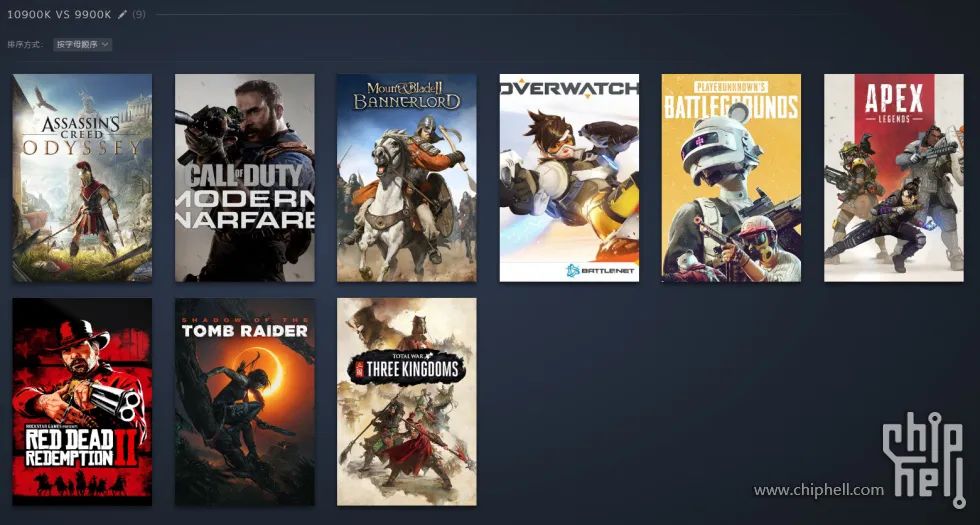 In terms of game selection, aside from “PUBG” released in 2017, the other games were all launched after 2018. Testing older games is less meaningful since hyper-threading may not significantly impact performance; even having more cores can lead to performance drops. Therefore, the latest games correspond to the latest CPUs. The specific list is shown above, with four games focusing on high frame rates and the others leaning towards AAA titles.
In terms of game selection, aside from “PUBG” released in 2017, the other games were all launched after 2018. Testing older games is less meaningful since hyper-threading may not significantly impact performance; even having more cores can lead to performance drops. Therefore, the latest games correspond to the latest CPUs. The specific list is shown above, with four games focusing on high frame rates and the others leaning towards AAA titles.
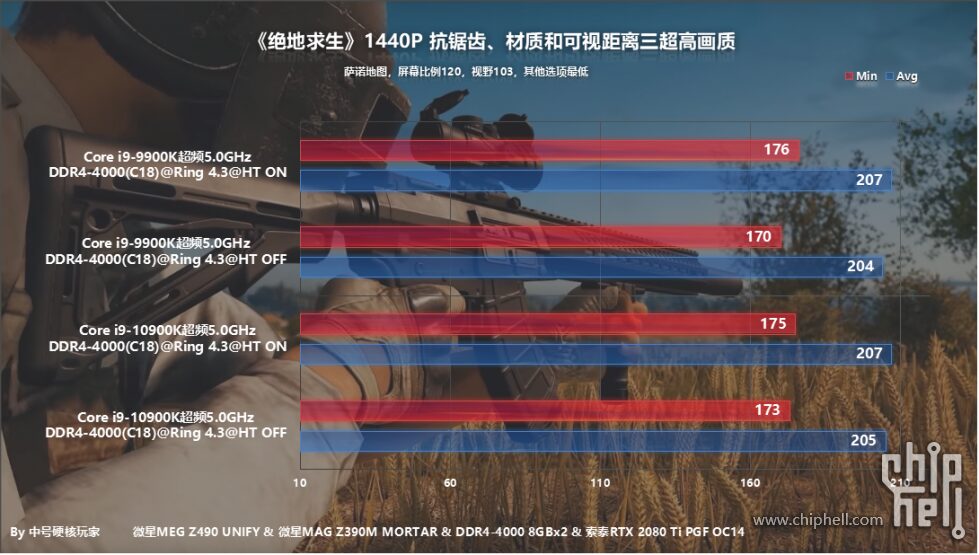
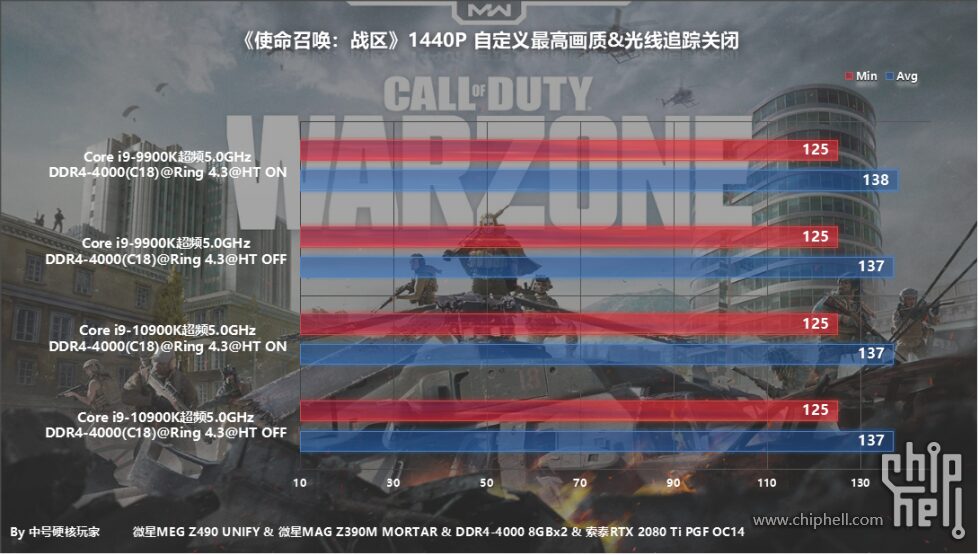
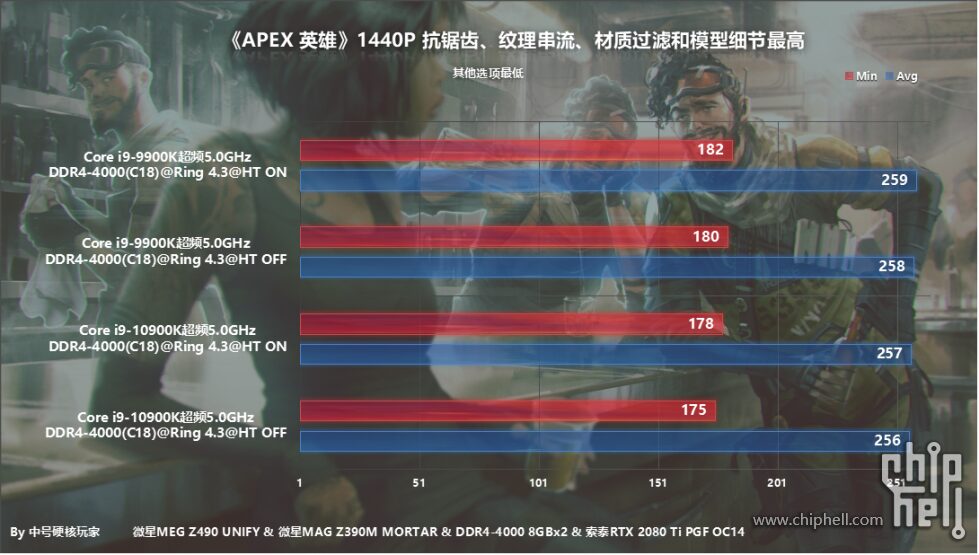





 As predicted, the performance difference between the i9-10900K and 9900K at 2K resolution is negligible, and the impact of disabling hyper-threading on performance is almost insignificant. Note that turning off hyper-threading on the 9900K is not equivalent to the 9700K at the same frequency; their L3 caches differ, along with other aspects that cannot be discerned at first glance.
As predicted, the performance difference between the i9-10900K and 9900K at 2K resolution is negligible, and the impact of disabling hyper-threading on performance is almost insignificant. Note that turning off hyper-threading on the 9900K is not equivalent to the 9700K at the same frequency; their L3 caches differ, along with other aspects that cannot be discerned at first glance.
Of course, CPU-intensive games like “Mount & Blade II” will show some differences, particularly with hyper-threading, especially as army sizes increase and the AI becomes more complex (for example, cavalry units are two AI units), further widening the gap. The same applies to games like “Civilization VI” and “Cities: Skylines.”
 The downside of the 9900K with hyper-threading off is that its eight cores are almost fully utilized.
The downside of the 9900K with hyper-threading off is that its eight cores are almost fully utilized.
So, is the 9900K still worth purchasing? Clearly, the answer is no, especially with the 10700K available, which generally offers better quality and improvements in die packaging, leading to higher frequencies and better temperature and power performance. Additionally, while Z490 motherboards have seen some price increases, their materials and craftsmanship have also improved, and they are likely to continue supporting the 11th generation Core processors. The entry-level product at 1500 yuan can overclock the 10700K, while the 2000 yuan mid-to-high-end can also drive the 10900K for overclocking.
Conclusion
The performance difference between the two generations of Core i9 CPUs in most high-resolution games is negligible, with some CPU-intensive games showing a difference. Looking ahead, the arrival of the RTX 30 series graphics cards will likely widen the gap. Additionally, it is important to note that the 10900K has advantages in terms of quality, power consumption, and temperature. For gamers who pursue gaming performance alongside video content creation or high-quality streaming, the 10900K is clearly more suitable, saving time and effort. If your budget is limited, the more affordable and readily available 10700K is also a better buy than the 9900K.































 9900K Platform
9900K Platform




















